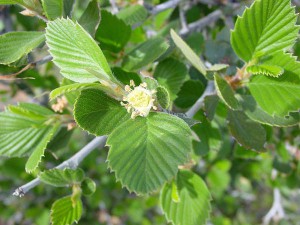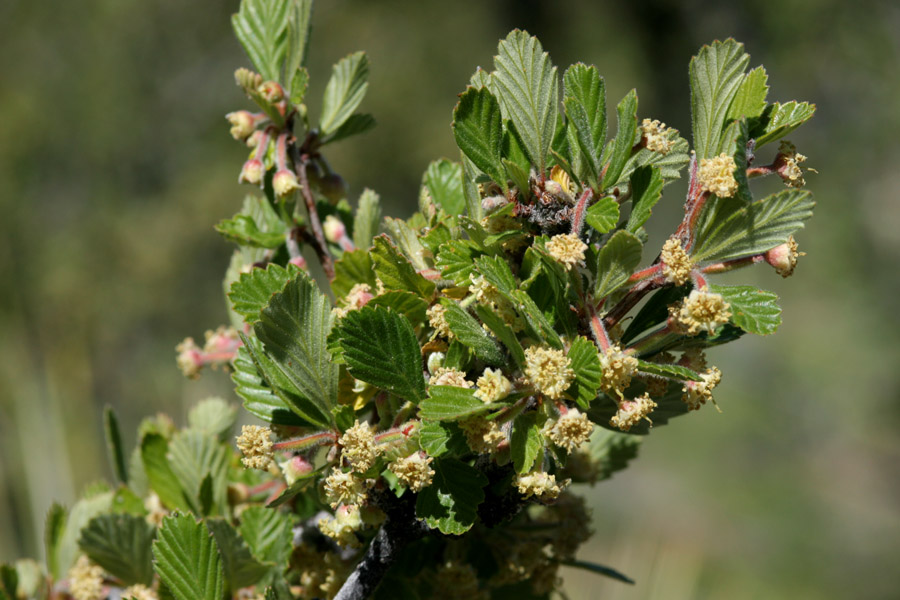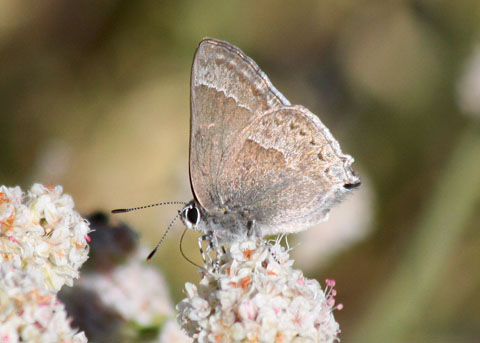Scientific name: Cercocarpus montanus
Common name: mountain mahogany
Plant family: Rosaceae
Article by Susan Bruneni
Mountain mahogany is a delightful feature of the new ethnobotanical gardens, Ojos y Manos: Eyes and Hands, and has been a useful plant in this area for centuries. The mountain mahogany is a shrub or small tree in the Rosaceae family, native to the Western United States. It is a broadleaf evergreen and grows in well-drained soil in full sun. It tolerates dry-to-medium moisture. Height ranges from 8-12 feet with a spread of 4-8 feet. In native habitats along chaparral, foothills or in lower mountain ranges it is preferred fodder for elk and mule deer and rarely reaches optimum height. In cultivated plantings, it is beneficial because it fixes nitrogen and is good for revegetation and erosion control.

Scientific Name: Cercocarpus montanus
Photographer: Shannon Doan
Manager: ASU Vascular Plant Herbarium
The early summer flowers are insignificant, but the resulting seed pods are showy, feathery, silvery-white fruits, occurring from May to November (depending on elevation). Dark green foliage turns russet in the fall.
Leonora Curtin included a description of mountain mahogany in her classic text, Healing Herbs of the Upper Rio Grande. She writes, “Palo duro, meaning hard wood, was given its Spanish name because of the extreme toughness of the trunks and branches, whereas its botanical name, taken from a combination of two Greek words, kerkos, tail, and karpos, fruit, was applied because the ripe seeds possess an airy, feathery tail that shimmers in the autumn sunlight and catches the eye with reflected brilliance……the wood of the palo duro has a bright red color when freshly cut and as it grows on bleak rocky slopes and hillsides, those of English stock have called it mountain mahogany.”
She continues, “at first glance, it seems far-fetched to include this tree in the rose family, but closer acquaintance with its very modest inconspicuous blossoms will convince you that there has been no botanical stretch of the imagination in placing it within that group.”

Scientific Name: Cercocarpus montanus
Photographer: Patrick Alexander
The wood is strong and durable, but too short and twisted for lumber use. Native Americans used it for small, handmade items such as bows, spearheads, and special sticks for extricating subterranean foods. Natives also used the tree medicinally, especially the bark, in the treatment of various ailments including colds. The hard wood is also excellent fuel, and was used to smelt ore during the Comstock era. Leonora Curtin commented that Spanish New Mexicans used the leafy twigs to keep away bedbugs. Tewa Indians prepared it for use as a laxative and Navajos used it as an ingredient in red dyes, she added.

Mountain mahogany hairstreak (Satyrium tetra), photo credit: John C. Avise
When you visit Ojos y Manos: Eyes and Hands during butterfly season, be on the lookout for the mountain mahogany hairstreak (Satyrium tetra). Mountain mahogany is its larval host.
References
Ladybird Wildflower Center
plants.USDA.gov
Healing Herbs of the Upper Rio Grande by Leonora Curtin.
Missouribotanicalgarden.org
nmsu.edu


